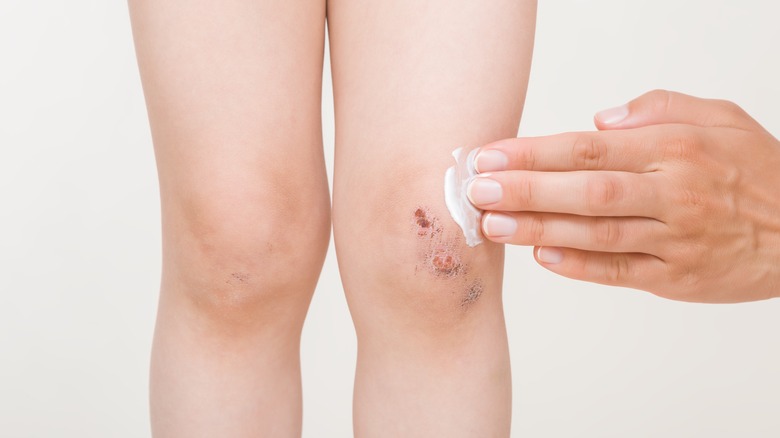Do Scabs Heal Faster On Wet Or Dry Skin?
When we were children, a scraped knee was usually tended to with some soap and water, a little antibiotic ointment, and a bandaid. After a day or so, maybe you were told to take the bandaid off so the wound could "breathe." While it's widely believed that a wound needs air to dry it out and form a scab in order to heal, the San Diego Wound Care Center says this is a common misconception.
When we incur a flesh wound, tiny fragments of cells called platelets immediately get to work converging around the wound (per The Franklin Institute). After recruiting the help of calcium, vitamin K, and the protein fibrinogen, these platelets begin forming a clot — putting an end to the bleeding and laying the groundwork for a scab. As air is introduced to the wound, the platelets use the fibrinogen protein to create fibrin threads, which lock together in a mesh-like formation, ensnaring the localized blood cells which will ultimately harden to form a scab — a dry crust that protects the wound while it heals.
While scabs have long been considered a benchmark in the healing process of wounds, it turns out they aren't necessarily required for healing. In fact, keeping a wound moist to prevent scabbing may promote better and faster recovery. Let's take a closer look.
Why moisture helps wounds heal faster
In 1962, Dr. George D. Winter published a study in Nature that revealed that (contrary to popular belief) superficial wounds healed exponentially faster when the wound bed was kept moist and scabbing was prevented. That's because our epithelial cells — which slide over wounds and seal our skin back together — need moisture in order to do so (per Coloplast Professional). When we let a wound dry out and a scab forms, these epithelial cells will have to find moisture elsewhere, often diving deep into the wound to get it. All of this extra travel can decelerate the healing process. When we expose a wound to air, we are actually encouraging cell death, which is counterintuitive to healing, according to the University of Pittsburgh Medical Center. In a moist environment, the cells our bodies use to heal can thrive, allowing them to be more efficient.
A speedy recovery isn't the only benefit of keeping a wound moist. When a wound is consistently moisturized, UPMC explains the formation of a scab becomes far less likely. Not only can this negate the pain and itching that often comes with a scab, but it may also reduce the occurrence of scarring. Five days of applying petroleum jelly to a covered wound should grant your skin the time and moisture it needs to get most of its healing done. And without that pesky scab lingering around for weeks, you'll feel good as new in record time.


